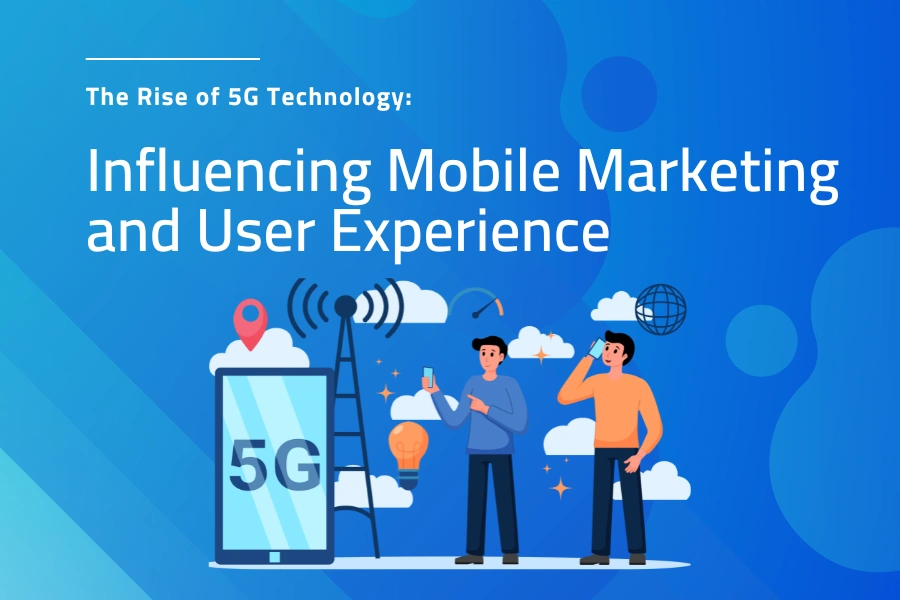The Rise of 5G Technology: Influencing Mobile Marketing and User Experience
The advent of 5G technology is poised to significantly transform mobile marketing and enhance user experience by providing faster speeds, lower latency, and greater connectivity. Here’s a detailed explanation of how 5G influences these areas:

1. Enhanced Speed and Performance
One of the most notable benefits of 5G technology is its extraordinary speed. With data transfer rates up to 100 times faster than 4G, 5G enables instant loading of content, including high-definition videos and complex mobile applications. This enhancement is crucial for mobile marketing as it allows brands to deliver richer, more immersive content without the risk of slow load times deterring users.
For example, marketers can leverage high-quality video ads, augmented reality (AR) experiences, and interactive content to engage users more effectively. The improved performance ensures that these rich media experiences are seamless and without buffering, leading to higher engagement and conversion rates.
2. Lower Latency for Real-Time Interactions
5G technology significantly reduces latency, the delay before data transfer begins following an instruction for its transfer. With latencies as low as one millisecond, real-time interactions become more feasible and efficient. This low latency is critical for applications requiring instant feedback, such as live streaming, gaming, and real-time customer service.
In mobile marketing, lower latency means that interactive ads and live content can be delivered more effectively. For instance, brands can use live polls, Q&A sessions, and instant messaging within ads to create a dynamic and interactive user experience. This immediacy enhances user engagement and provides a more compelling and responsive marketing approach.
3. Increased Connectivity and Reach
5G technology supports a higher density of connected devices per unit area, which is essential for the growing number of mobile devices and the Internet of Things (IoT). This increased connectivity means that marketers can reach users across more devices and touchpoints, creating more comprehensive and integrated marketing campaigns.
For instance, marketers can target users not only through smartphones but also through connected devices like smartwatches, AR/VR headsets, and IoT-enabled household appliances. This expanded reach allows for more personalised and contextually relevant marketing messages, enhancing the overall user experience.
4. Augmented Reality (AR) and Virtual Reality (VR) Integration
The enhanced capabilities of 5G support the seamless integration of AR and VR technologies in mobile marketing. These technologies require substantial data bandwidth and low latency to function effectively, both of which are provided by 5G.
With 5G, marketers can create immersive AR and VR experiences that can be accessed on mobile devices. For example, users can virtually try on clothes, visualise furniture in their home, or participate in virtual events. These interactive experiences not only enhance user engagement but also provide valuable insights into consumer preferences and behaviour.
5. Improved Data Collection and Analysis
The high speed and low latency of 5G enable more efficient and detailed data collection from mobile devices. This capability allows marketers to gather real-time insights into user behaviour, preferences, and interactions with mobile content.
Enhanced data collection means that marketers can analyse trends and patterns more accurately, leading to better-targeted and more effective marketing campaigns. Real-time analytics enable marketers to make immediate adjustments to their strategies, optimising campaign performance and enhancing the user experience.
6. Enhanced Mobile Commerce (mCommerce)
With the improved speed and reliability of 5G, mobile commerce experiences are becoming more seamless and secure. Faster transaction processing and real-time verification enhance the user experience, making mobile shopping more appealing.
For marketers, this means higher conversion rates and the ability to offer more sophisticated mCommerce features such as instant checkout, personalised recommendations, and interactive product demos. These enhancements make shopping on mobile devices more intuitive and enjoyable, driving increased sales and customer loyalty.
The rise of 5G technology significantly influences mobile marketing and user experience by providing enhanced speed, lower latency, greater connectivity, and support for advanced technologies like AR and VR. These improvements enable marketers to deliver richer, more interactive, and personalised content, enhancing user engagement and satisfaction. As 5G continues to roll out globally, its impact on mobile marketing and user experience will only grow, creating new opportunities for innovation and growth in the digital landscape.
Active Events
From Insights to Impact: Proven B2B Marketing Strategies for Scalable Success
Date: Feburary 28, 2025 | 7:00 PM(IST)
7:00 PM(IST) - 8:10 PM(IST)
2811 people have registered
3 Must Have Projects On your CV to Get into Data Analysis
Date: Feburary 25, 2025 | 7:00 PM(IST)
7:00 PM(IST) - 8:10 PM(IST)
2753 people registered
Bootcamps
Digital Marketing Bootcamp
- Duration:4 Months
- Start Date:Feb 9, 2025
Data Science Bootcamp
- Duration:4 Months
- Start Date:Feb 9, 2025
